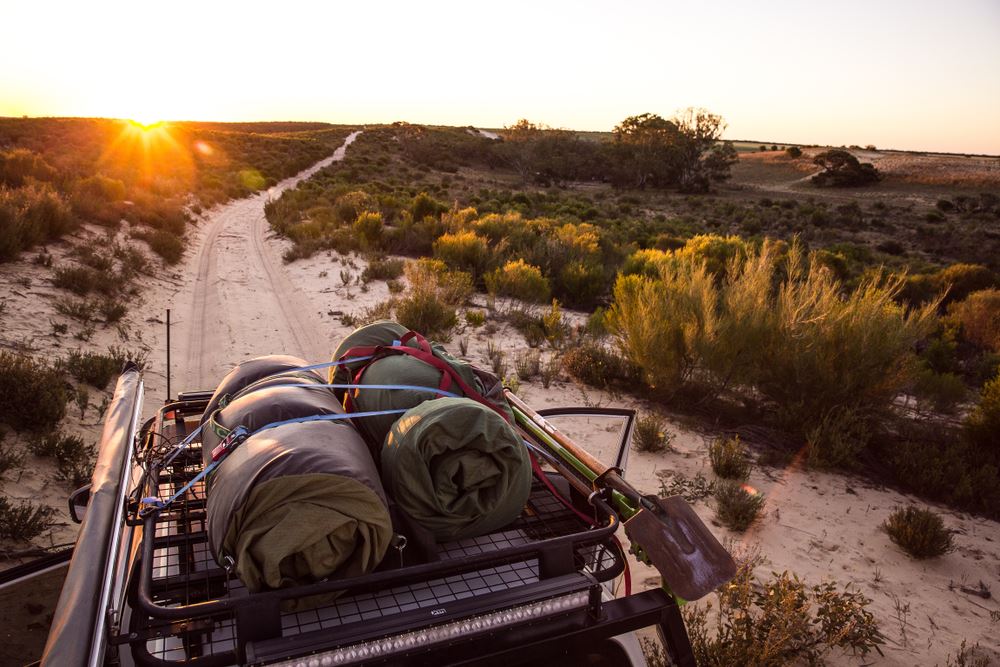
If you’ve done some 4x4 touring in the past, you would have seen that most vehicles were rigged with some sort of roof rack system to haul all of the gear needed for their journey. But there’s more to 4x4 roof racks than whacking on a set, piling them up and calling it a day. In this guide, we’re checking out the different types of roof racks, roof rack mounting, roof rack weight limits, and what can accidentally happen if you overload yours.
4x4 Roof Rack Types:
There are plenty of 4x4 roof rack options out there, but they all share the same purpose: to add extra storage capacity to your car. They’re great for hauling everything from mountain bikes to rooftop tents, but some perform better than others.
Roof Bars or Roof Rails:
These are the simplest form of roof racks available, meaning that you can be limited when it comes to what you can attach to them. If you’re just heading out fishing for the day or only need to carry a lightweight tent, surfboard or ladder – or anything that can easily sit on top of the bars – they’ll work just fine. They are usually adjustable to sit further apart or closer together but you do need to attach them to lip of your vehicle, especially older models will have this roof design. These are called 'gutter mount' roof racks and a lot of new model vehicles do not have this roof lip and will therefore need roof bars to be attached directly to the sheet metal. You find universal ones or for roof racks that will compliment the look of your exact 4WD model check out the ones from Front Runner. You can also find more options for roof rails from Rhino Rack.
Roof Rack Kits:
Roof rack kits contain everything you need to install your roof racks yourself, and come in a variety of styles. They’re most often flat with bars that run across your vehicle and can carry larger items such as kayaks, tents, bikes and luggage. Our most popular roof rack system by far is the Rhino Rack Pioneer platform or the Rack Kits from Front Runner. Depending on the design and personal style most of these platforms will come with a back bone that is mounted to the roof on the car with just a few drill holes. Roof rack kits offer a far more superior load bearing platform with multiple accessories to choose from as well as more oppurtunity to rachet strap more awkward and bulky items.
4x4 Roof Baskets:
Sort of what they sound like, really! Baskets are a form of roof rack made from metal with high edges and mesh in between. You can carry a variety of gear in them, making them far more useful than standard roof bars. Check out our most popular roof basket kits from MSA.
Full-Length Cages:
Similar to basket, this form of 4x4 roof rack is larger and more heavy duty. If you’re touring full-time or have a lot of gear to haul – including water tanks and spare fuel – this is the option we recommend. Many of the roof platfroms from Rhino Rack or Front Runner can have side rails, rear and back rails installed to provide extra support for heavier items. This means you do not have to remove the platform if you already have one, check out the range of additional accessories to suit.
On-Road vs. 4x4 Roof Racks:
Roof racks come with different ratings, so it’s worth paying attention to them. Roof racks with on-road only ratings are not suitable to be driven on anything other than sealed roads, while those with an off-road rating are safe to safe to take on uneven, unsealed and dirt roads.
4x4 Roof Rack Mounting Options:
4x4 roof rack mounting usually comes down to the type of roof racks you've chosen and the design of your vehicle. Remember: always measure the roof racks you intend to purchase and be sure that they will fit properly on your vehicle, or you could be in for a nasty mess right in the middle of your 4x4 touring.
The most common 4x4 roof rack mounting options are bolts and clamps, which are far more secure than the types of roof racks that adopt straps that run through the interior of your vehicle. If your vehicle has gutters, there are roof racks that clamp around them. If you find that your 4x4 doesn’t have gutters, you may be able to obtain roof racks that clamp to the roof instead by going around the metal on the inside of the point where your doors shut. Another option is to bolt your racks directly to your car. If you find that your roof racks are sliding, they’re not right for 4x4 touring.
What To Carry On Roof Racks:
One of the issues we most commonly see occurring with roof racks is that, due to their convenience, people tend to throw everything that doesn’t fit in their vehicle on them. This isn’t a good idea: roof racks are designed to carry a certain amount of weight (legally between 80 – 100kg), and if you overload your roof racks you risk damaging your vehicle (more on overloading issues soon). Knowing your roof rack weight limit is therefore important. Depending on the type of roof racks you have installed, you are safe to carry large yet lightweight items. Rooftop tents are fine too, since these are specifically designed to be on the roof of your 4x4. Swags, tents, chairs, light tool boxes, solar panels, one or two jerry cans, surfboards, recovery tracks, tables, awnings and tarps are all suitable for roof racks.
Why You Shouldn’t Overload Your Roof Racks:
Overloading your 4x4’s roof racks can lead to a bunch of problems. Firstly, you’ll have an issue with centre of gravity, which is paramount to 4WDing. If your roof racks are overloaded, your centre of gravity is going to be much higher, which will make your vehicle difficult to handle and can cause it to tip over on rough tracks. It can also cause excess stress on your 4x4, increase wind resistance, and can negatively impact your fuel usage. Sticking to your roof rack weight limit is much safer – your vehicle can twist and turn and bounce up and down all day and come out the other side with no issues. Need some more 4WDing tips? Check out our guide to river crossings, tips for towing a caravan for the first time, and what to consider when driving on the beach.


.png)
Leave a comment